How to grow Lilium
Also known as lilies, lilium are grown for their showy, sometimes fragrant flowers, beloved by gardeners and florists alike. Offering a vast choice of colour and flower form, they tend to bloom at a useful point in the gardening calendar, often as the early summer flowers are beginning to run out of steam and the late season interest is yet to get going.
This enormous genus of plants is split into several divisions, each with different attributes and growing requirements. Our growing guide will break this down into simple, easy to digest tips to help you get the best from your lily of choice.
It is worth noting here that all parts of lilies can be fatal to cats, so if you are a cat owner you may do best to opt for an alternative such as freesia, nepeta, cornflower, cosmos, diascia, nemesia, and snapdragon - all recommended by The Cats Protection League.
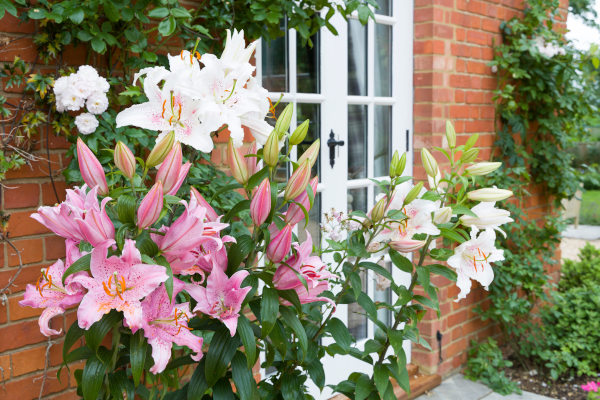
Key Information
Soil pH
Position
Hardiness


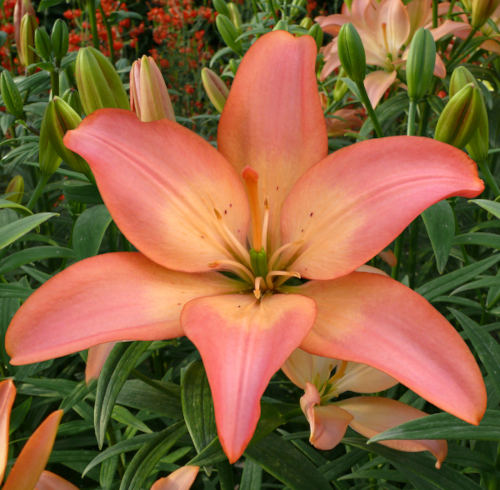
Horticultural Divisions-
Regal lily (L. regale) Probably the most widely grown garden lily, traditionally planted underneath cottage windows to scent the room. Each stem bears up to 16 highly fragrant trumpet shaped flowers, often white with a dusky pink reverse.
Asiatic lily Hybrids bred for bright and vivid colours, including yellow, orange, red, and almost black. Their flowers tend to be small and upwards facing. Though rarely scented, they are extremely hardy and happy in a wide range of soil types, meaning they are easy to grow and recommended for beginners.
Trumpet lily These tend to be taller than most and are often referred to as ‘tree lilies’. Their flowers have long throats and are usually scented.
Oriental lily Typically large, fragrant, pink flowers on tall stems. This type strongly prefers acid soil (grow in a pot with ericacous compost if your garden doesn’t have this), and requires staked support, though is well worth the effort.
Easter lily (L. longiflorum) Popular as a cut flower or seasonal gift plant for indoors, though can also be planted outside in a warm, sheltered spot. Bears white, fragrant flowers and is happy in alkaline soil.
Martagon lily Of all the lilies this is the most shade tolerant (though still needs some sunlight, so avoid full shade). Each stem bears up to 30 delicate, recurved flowers, known as turkscap. Often self-seeds and will naturalise beneath deciduous trees.
Tiger lily (L. lancifolium) Unscented, turkscap-type, vibrant orange flowers with dark speckles. Happiest in damp, acid soil.
Madonna lily (L. candidum) Smaller and more lightly scented flowers than those of the regal lily. Unlike most lilies it enjoys a sunbaked spot and does well on chalky, alkaline soil.
Leopard lily (L. pardalinum) Similar to tiger lily though earlier to bloom and with more tapered, star-like flowers.
True species These are the lilies which don’t fall into any of the divisions, and instead are known by their individual species name. L. henryi and L. auratum are a couple of examples.
Where & when to plant Lilium
Lilies can be bought both as bare bulbs and as pot-grown plants. In theory, pot-grown plants can be planted at any time of year, though best results come from an autumn or spring planting.
Bare bulbs are in peak condition for planting in autumn, though it must be said that this is not without risks. Between rotting off in cold, damp soil, underground slugs, hungry, digging animals, and inadvertent spade damage, there are many threats to the survival of an autumn-planted lily bulb. Planting in spring is in some ways the safer option, though the drawback is that it gives the bulb less time to settle before growth starts and tends to result in a less vigorous show. Many bulbs will be unviable by spring too, having shrivelled or already started to sprout. If you can, it is worth hedging your bets by carrying out two plantings. Just make sure you mark where the autumn planted bulbs are to avoid trowel-damage in spring.
In terms of choosing a spot, lilies enjoy the same feet in shade, head in sun formula as clematis. Grow them through the low branches of shrubs, or amongst dense, early showing perennials. Martagon, tiger, and leopard lilies enjoy the dappled shade beneath deciduous trees and shrubs.
If you have heavy soil, we recommend planting lilies in pots. These can be either decorative to go on show, or plastic for plunging into beds and borders wherever a floral boost is needed in summer.
One final thing to note when it comes to choosing a spot is that the pollen produced by many lilies can stain clothing, so try to avoid planting anywhere you may brush up against them. Alternatively, go for pollen-free cultivars such as the Asiatic ‘Easy Vanilla’ and ‘Easy Whisper’ forms.
How to plant Lilium
- For planting into the ground, start by digging the soil area over, removing any large stones and weeds and breaking up any lumps.
- Rake level and firm with your heels. Rake level again.
- Plant each bulb (pointy side up), at a depth of 2-3 times its height, with the distance between bulbs equivalent to 3 times their diameter.
- It can be useful to mark with a cane or label where you have planted your lily bulbs, to avoid damaging them with a spade or fork at a later date (this is a particularly good idea for autumn planted bulbs). Just take care not to damage the bulb when inserting these.
- For planting in containers, first choose a deep pot with plenty of drainage holes in the bottom. A large one with 7-10 bulbs in is much more impressive than several smaller pots clustered together. Remember that like all bulbs, lilies can be planted more closely together in a pot than in the ground.
- If you are using a large or heavy pot, it can be a good idea to fill and plant it in situ to save yourself the trouble of moving once full.
- Use a good quality potting compost (ericaceous if you can) with plenty of horticultural grit mixed in, and, if not already present in the compost (check the description on the bag) some slow-release fertiliser granules.
- Pot up the bulbs, following the depth guidelines above and leaving a gap of a few centimetres between the surface of the compost and the top of the pot. This makes watering easier and more efficient.
- Pick up the pot and lightly tap on the potting bench or ground a few times to help further settle the compost around the plant.
- Soak well with water.
- A mulch with horticultural grit will look attractive and help to prevent a ‘cap’ or crust forming on the top of the compost (something container plants can suffer due to the artificial nature of their watering). It also prevents blackbirds tossing the compost about.
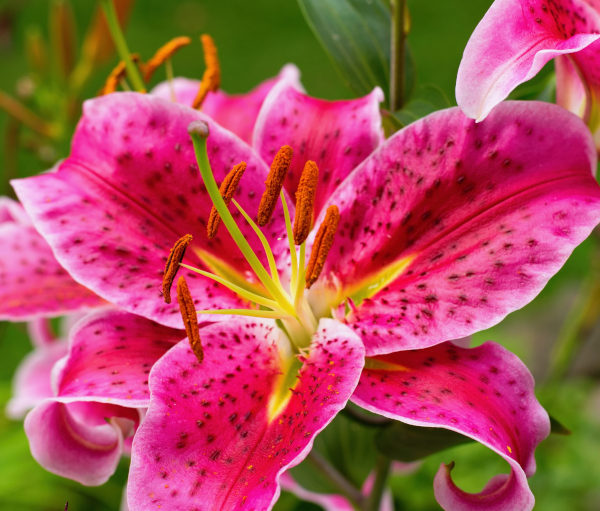
What to plant with Lilium
Planting amongst neighbours which put on lots of leafy growth early in the season will help to achieve the cool, shady soil conditions lilies prefer, while still allowing the flowering stems full access to sunlight. Perennials such as geranium, euphorbia, digitalis, cirsium, and astrantia are ideal.
Those species happy in dappled shade (martagon, tiger, and leopard lilies) go beautifully with similarly inclined companions such as ferns, hostas, tiarella, aquilegia, and brunnera.
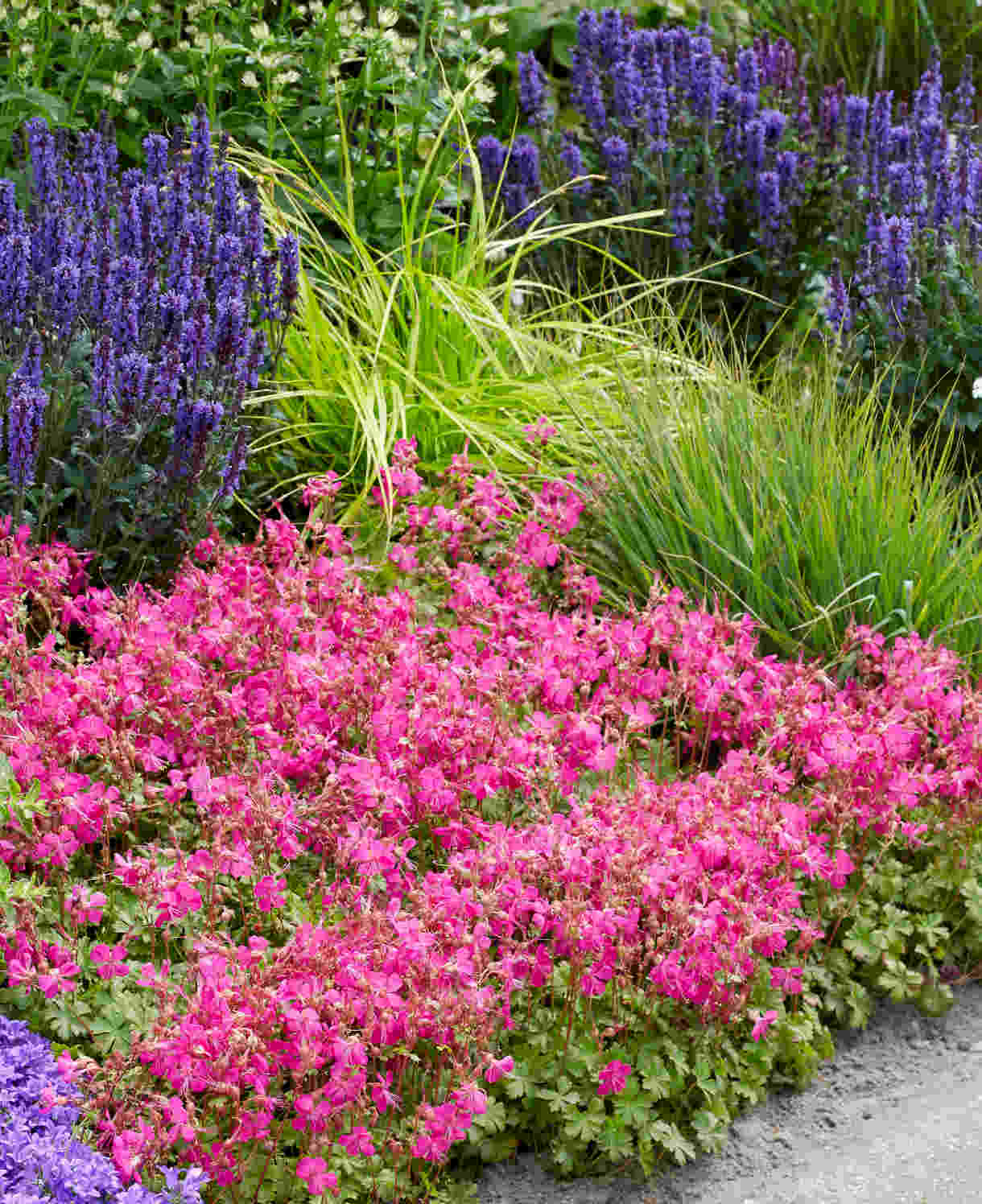
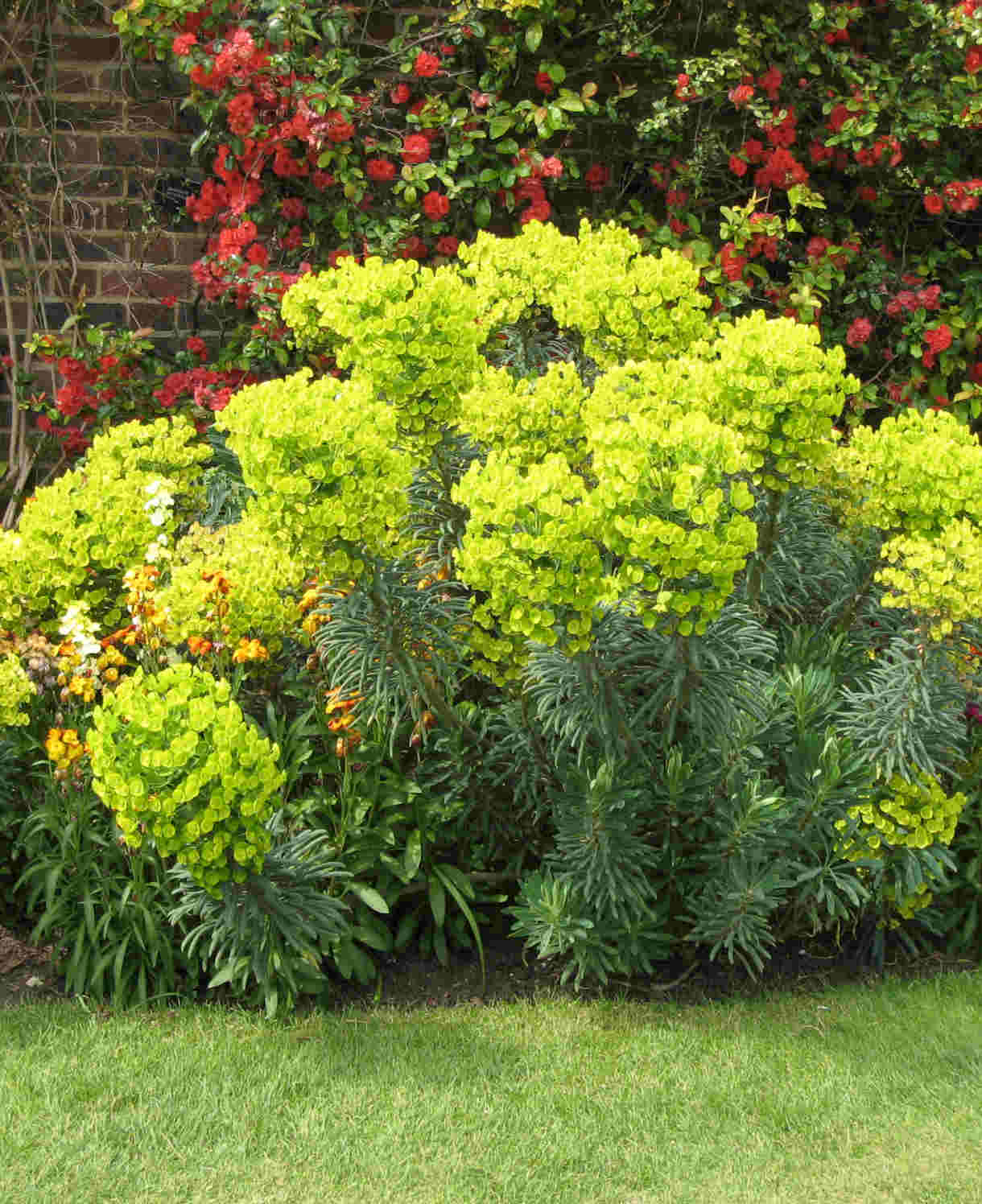

How to care for Lilium
Pruning and Deadheading
Deadhead spent flowers to prevent energy being wasted on seed production. The exception to this is if you wish to encourage the self-seeding of naturalising types such as martagon, tiger, or leopard lilies, in which case leave flowerheads intact for as long as possible.
As they also bear leaves which are vital for directing energy into the bulb, the flowering stems of lily should not be cut right down to the ground when deadheading. Instead, simply snip the top third off (to just above a set of leaves), leaving the rest in place until it naturally browns off later in the season. The same rule applies when cutting lilies for fresh flower arrangements. Without these weeks of posts-flowering photosynthesis, the bulb is unlikely to bulk up enough to perform well the following year.
Once the remaining stems and leaves have turned brown, cut back to 10-15 centimetres for winter. Lillies can be delicate and vulnerable to diseases, so always use clean, sharp secateurs when pruning.
Watering
Lilies don’t like to dry out completely, nor will they tolerate becoming waterlogged. In reasonable garden soil with an annual mulch (more on this in the next section), they should be self-sufficient when it comes to water. When grown in a container, keep well-watered throughout the growing season (allowing the top few centimetres of compost to dry out between each soaking), then barely moist during winter. Lilies need a cold spell, so rather than bringing pots indoors to protect from the rain you may wish to cover them with a cloche or dustbin lid or turn them on their sides. An unheated greenhouse is also fine, as long as it remains cool.
Feeding
On healthy, fertile soil, a mulch of well-rotted organic matter (i.e., a layer of leaf mould, manure, or garden compost applied to the soil around the plant) should provide sufficient nutrients for lilies. This has the added benefit of suppressing weeds and locking in moisture. Mulch when planting, and then again each spring.
If you garden on poor soil or your lilies seem in need of a boost, applying a general-purpose granular feed to the surface of the soil and lightly working in can reap benefits. This is known as a top dress and should be done to coincide with mulching in spring – first apply the feed, then cover with the mulch.
Container-grown plants are different as they rely solely on the gardener for nutrition. Get off to a flying start by making sure you use a good quality compost with some slow-release granules mixed in, then throughout the growing season apply a balanced liquid feed every two weeks (tomato feed is perfect). This both encourages good flowering and helps the bulb perform well the following year.
Cold Protection
Most lilies are fully hardy and should withstand a UK winter without the need for additional protection. The thing to avoid is excessive winter wet – see our tips above for keeping container-grown lilies dry in winter.
Easter lilies are less hardy. Either plant in a warm, sheltered, well-draining spot outside, or grow in a container and overwinter indoors.
Pests and Diseases
There are several threats to lily health. Lily beetles are a new-ish enemy; look out for shredded leaves and bright red beetles on the plant which, fortunately, are slow moving and easy to catch. Pick off and dispose of by hand.
Vine weevil can be an issue for container-grown lilies, identified by tell-tale notching on the edges of leaves. Slugs, snails, and aphids may also descend on the fresh, new growth of stems and leaves. Encouraging natural predators into the garden is the most sustainable line of defence, including birds, frogs, toads, shrews, hedgehogs, and ground beetles. Evening, torchlit searches can also be very effective, allowing you to pick off and destroy what are often nocturnal pests.
In a wet, cool spring grey mould can be a problem. Remove and destroy all affected parts of the plant. Where the entire bulb has to be discarded, it’s best to avoid planting lilies in the same spot for a few years.
Viruses may also be troublesome, though thankfully many of the newer varieties are now disease resistant.
How to propagate Lilium
The easiest way to propagate lilies is to lift and divide every three to four years. Not only does this produce new plants, but it also breathes life into tiring clumps.
1. In autumn once the plant has died back, carefully lift out of the ground with a garden fork.
2. Gently peel the bulbs apart by hand.
3. Either replant as smaller clumps or pot up as above.
* Many plants carry Plant Breeders Rights and cannot be propagated for commercial purposes.
Common Lilium questions
Do lilies come back every year/ how many years do lily bulbs last?
Lilies are bulbous perennials which die back each autumn and regrow the following spring. After three to four years, they may begin to run out of steam, at which point it is advisable to either lift and divide (as above) or start afresh with new bulbs.
What do I do when lilies have finished flowering?
Unless you wish to encourage self-seeding (applicable to martagon, tiger, and leopard types), lilies should be deadheaded to divert energy away from unnecessary seed production and instead back into the bulb for good growth the following year. Follow our deadheading guide above.
Do lilies need a lot of water?
Like many plants, lilies enjoy a moderate supply of water – not too wet, nor too dry. In a hot, dry year you may find yourself having to water lots. In wetter years little intervention will be needed. See our ‘Watering’ section above for more information.
Should I soak lily bulbs before planting?
There is no need to soak lily bulbs. If they have become shrivelled and dry, they are unlikely to grow well and are best discarded.
Should I stake my lilies?
Taller varieties will benefit from staked support. A cane carefully inserted into the soil (avoiding the bulb) is ideal. For larger drifts, try instead a few cut hazel branches inserted into the soil and woven together. Do this in spring just as the early shoots are beginning to show – plants which grow up and through supports look much more natural than those hoisted back post-flopping.





